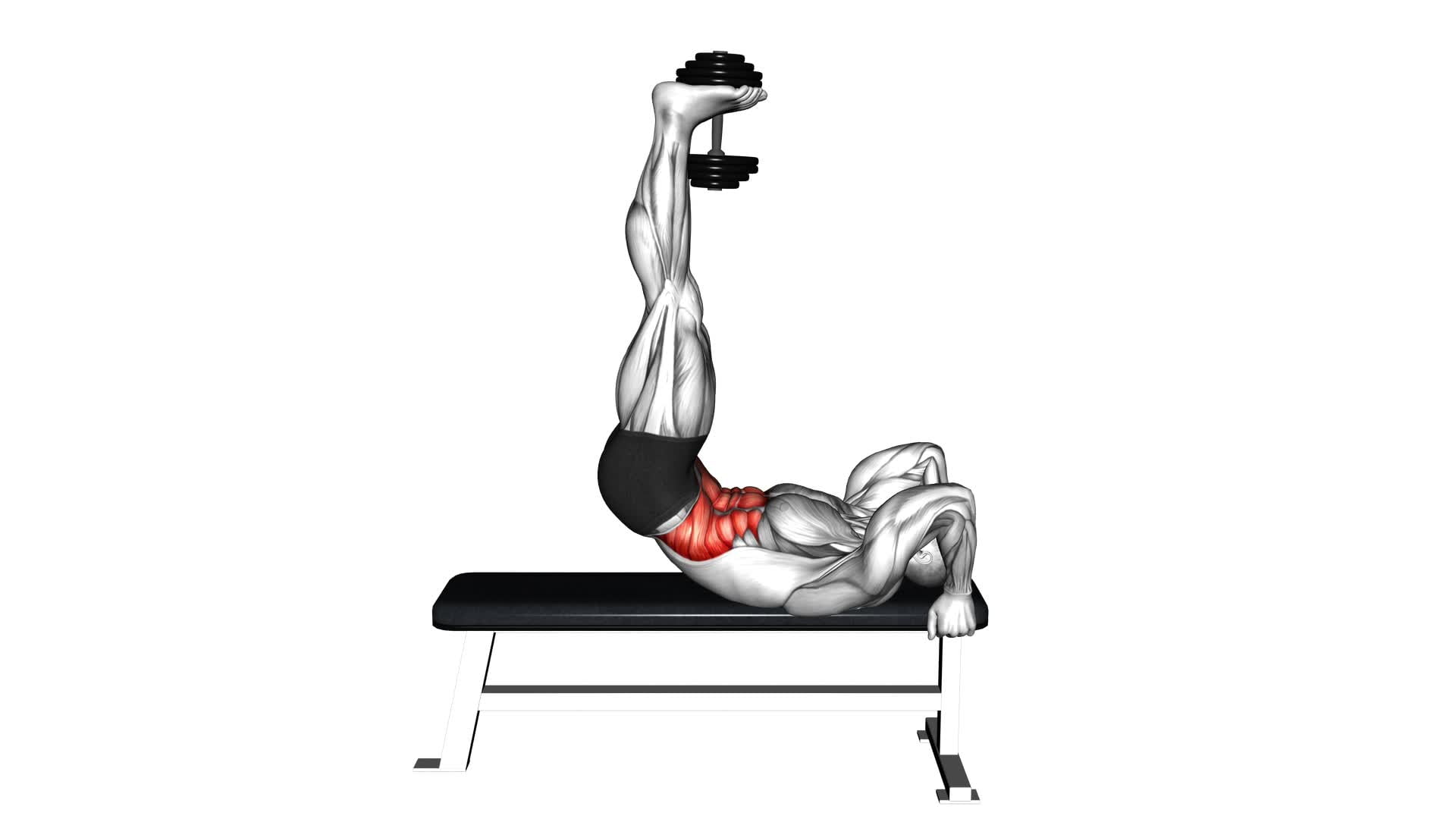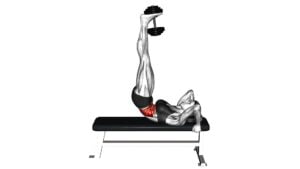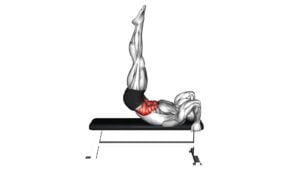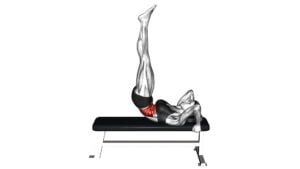Weighted Dumbbell Lying Flat Hip Raise (male) – Video Exercise Guide & Tips

Looking to strengthen your lower body and core? Check out the weighted dumbbell lying flat hip raise. This video exercise guide and tips will show you how to perform the movement with proper form and technique.
Watch This Exercise Video
Learn how to choose the right weight and avoid common mistakes. Plus, discover modifications for different fitness levels and get tips for maximizing your results.
Get ready to take your workout to the next level!
Key Takeaways
- Weighted Dumbbell Hip Raise targets glutes, hamstrings, and lower back.
- Proper form and technique are crucial for engaging the correct muscles and preventing injury.
- Choosing the right weight is important for controlled and smooth movements.
- Modifications and variations can be made to accommodate different fitness levels and goals.
Benefits of Weighted Dumbbell Hip Raise
To maximize the effectiveness of your workout, incorporate weighted dumbbell hip raises into your routine for enhanced strength and muscle development. The benefits of weighted dumbbell hip raises are numerous.
Firstly, they target your glutes, hamstrings, and lower back, helping to tone and strengthen these areas. By adding resistance with dumbbells, you increase the challenge and force your muscles to work harder, leading to greater gains in strength and muscle mass. This exercise also improves hip mobility and stability, which can benefit your overall athletic performance and reduce the risk of injury.
Furthermore, weighted dumbbell hip raises offer variations that allow you to target specific muscle groups. For example, by positioning the dumbbell on your lower abdomen instead of your hips, you place more emphasis on your lower abs, making it an effective exercise for core strength and stability. You can also perform single-leg hip raises to further engage your glutes and hamstrings. Adding different variations to your routine not only adds variety but also ensures that you're working all muscle groups evenly.
Incorporating weighted dumbbell hip raises into your workout routine can provide numerous benefits, including enhanced strength, muscle development, improved hip mobility, and stability. By incorporating variations, you can target specific muscle groups and add variety to your routine. Remember to start with a weight that challenges you but allows for proper form, and gradually increase the weight as you get stronger.
Proper Form and Technique
To perform the weighted dumbbell lying flat hip raise exercise with proper form and technique, follow these steps:
- Grab a pair of dumbbells that challenge your muscles but still allow for proper execution.
- Lie flat on your back with your knees bent and your feet flat on the ground.
- Hold the dumbbells securely against your hips, ensuring a firm grip.
- Engage your glutes by squeezing them tightly.
- Lift your hips off the ground, pushing through your heels.
- Keep your core engaged and your back flat throughout the movement.
- Avoid arching your back or using momentum to lift your hips.
- Maintain control as you lower your hips back down to the starting position.
One common mistake to watch out for is not fully engaging your glutes. It's important to consciously contract your glute muscles throughout the exercise to ensure they're doing the majority of the work. Another mistake is using too heavy of a weight, which can lead to poor form and increased risk of injury. It's better to start with a lighter weight and gradually increase as you become more comfortable and confident with the movement.
Choosing the Right Weight
When choosing the right weight for the weighted dumbbell lying flat hip raise exercise, consider your current strength level and ensure that the weight challenges your muscles without compromising form. Proper weight selection is crucial in weightlifting to ensure that you derive maximum benefits from your workout while minimizing the risk of injury.
To choose the appropriate weight for the weighted dumbbell lying flat hip raise, start by assessing your current strength level. If you're a beginner or have limited experience with this exercise, it's best to start with a lighter weight. This will allow you to focus on maintaining proper form and technique without straining your muscles excessively.
As you become more comfortable with the exercise and your strength improves, gradually increase the weight to continue challenging your muscles. However, be cautious not to choose a weight that's too heavy, as this can compromise your form and increase the risk of injury.
A good rule of thumb is to select a weight that allows you to perform the exercise with controlled and smooth movements while feeling a moderate level of difficulty in your target muscles. This will ensure that you're effectively engaging your muscles and progressing towards your fitness goals.
Common Mistakes to Avoid
When performing the weighted dumbbell lying flat hip raise, it's important to be aware of common mistakes in form to avoid potential dangers and maximize results.
One common mistake isn't engaging the glutes properly, which can lead to ineffective workouts and potential strain on other muscles.
Incorrect Form Dangers
Avoid putting too much weight on the dumbbells during the weighted dumbbell lying flat hip raise exercise to prevent incorrect form and potential injuries. Maintaining proper technique is crucial to ensure a safe and effective workout.
Here are some dangers of incorrect form and the importance of proper technique:
- Straining your lower back: If you use excessive weight or lift your hips too high, you can strain your lower back, leading to pain and potential long-term damage.
- Neglecting the core muscles: Failing to engage your core during this exercise can put unnecessary stress on your lower back and limit the effectiveness of the movement.
- Overarching your lower back: Avoid arching your lower back excessively, as this can lead to discomfort and strain your back muscles.
- Using momentum: Swinging your legs or using momentum to raise your hips takes away the focus from the targeted muscles, reducing the effectiveness of the exercise.
- Not breathing properly: Remember to breathe steadily throughout the exercise, as holding your breath can increase blood pressure and strain your body.
Not Engaging Glutes
To prevent the common mistake of not engaging your glutes during the weighted dumbbell lying flat hip raise, focus on activating your glute muscles throughout the exercise. Glute activation is crucial for maximizing the effectiveness of this exercise and targeting the right muscles.
When performing the hip raise, make sure to squeeze your glutes at the top of the movement and maintain tension in your glute muscles throughout the entire range of motion. This will ensure that you're properly engaging your glutes and getting the most out of the exercise.
Additionally, it's important to work on hip mobility to allow for a full range of motion during the hip raise. Improving hip mobility will help you maintain proper form and engage your glutes more effectively.
Remember to prioritize glute activation and hip mobility to get the most out of the weighted dumbbell lying flat hip raise.
Modifications for Different Fitness Levels
Now let's talk about modifications you can make to the Weighted Dumbbell Lying Flat Hip Raise based on your fitness level.
If you're a beginner, there are options to make the exercise more manageable for you.
If you're at an intermediate level, there are adjustments you can make to challenge yourself further.
And if you're an advanced fitness enthusiast, there are variations that will push you to your limits.
Let's explore these options to help you get the most out of this exercise.
Beginner Modification Options
Start with using lighter weights and focusing on proper form. Here are some beginner modification options to help you progress in the weighted dumbbell lying flat hip raise exercise:
- Reduce the weight: Start with lighter dumbbells to build strength and gradually increase the weight as you become more comfortable.
- Perform without weights: If you're just starting out or prefer bodyweight exercises, you can do the hip raise without any additional weights.
- Use a resistance band: Attach a resistance band around your thighs to add extra resistance and make the exercise more challenging.
- Elevate your upper body: Place a yoga block or cushion under your upper back to reduce the range of motion and make the exercise easier.
- Perform the exercise on a stability ball: By lying on a stability ball, you'll engage more stabilizing muscles and increase the difficulty level.
Remember to listen to your body and progress at a pace that feels comfortable for you.
Intermediate Level Adjustments
As you progress to an intermediate level in the weighted dumbbell lying flat hip raise exercise, you can further challenge yourself and modify the exercise to suit your fitness level.
To adjust the difficulty, you can increase the weight of the dumbbell or use a barbell instead. Additionally, you can try performing the exercise on an unstable surface, such as a stability ball, to engage your core muscles even more.
Progressions for the intermediate level include extending your legs fully, rather than keeping them bent, and increasing the range of motion by lowering your hips closer to the ground.
On the other hand, if you find the exercise too challenging, you can regress by decreasing the weight or performing the movement with your feet on the ground instead of elevated. These modifications will help you continue to build strength and stability as you advance.
Now, let's explore advanced variations for experts.
Advanced Variations for Experts
To further challenge yourself in the weighted dumbbell lying flat hip raise exercise, as an expert, you can explore advanced variations and modifications to cater to different fitness levels. Here are some advanced progressions and techniques you can try:
- Single-leg weighted dumbbell lying flat hip raise: Perform the exercise with only one leg at a time, adding an extra challenge to your core stability and hip strength.
- Elevated weighted dumbbell lying flat hip raise: Place your feet on an elevated surface, such as a bench or step, to increase the range of motion and target your glutes and hamstrings even more.
- Weighted dumbbell lying flat hip raise with pause: Hold the raised position for a few seconds before lowering your hips back down, adding an isometric contraction to the exercise.
- Banded weighted dumbbell lying flat hip raise: Add resistance by using a resistance band around your thighs, increasing the activation of your glute muscles.
- Weighted dumbbell lying flat hip raise with a twist: As you raise your hips, rotate your torso to one side, engaging your oblique muscles and adding an extra challenge to your core stability.
Remember to always maintain proper form and gradually increase the difficulty level as you progress.
Tips for Maximizing Results
To maximize your results, focus on using proper form and engaging your hip muscles throughout the entire movement. This exercise is designed to target your hip flexors and glutes, so it's important to maintain control and ensure that these muscles are doing the work.
One of the most effective workout strategies for maximizing gains with the weighted dumbbell lying flat hip raise is to start with a weight that challenges you, but allows you to maintain proper form. Gradually increase the weight as you become stronger and more comfortable with the exercise. This progressive overload will help to stimulate muscle growth and increase strength over time.
Another tip for maximizing results is to incorporate tempo variations into your workout. By slowing down the lowering phase of the movement and focusing on the negative portion of the exercise, you can increase the time under tension and create more muscle damage, leading to greater gains in strength and size.
Lastly, don't forget to breathe! It's easy to hold your breath during this exercise, but proper breathing can help you maintain control and stability. Inhale as you lower the weight and exhale as you raise it back up.
Frequently Asked Questions
What Are Some Alternative Exercises That Can Target the Same Muscle Groups as the Weighted Dumbbell Lying Flat Hip Raise?
Looking for alternative exercises that target the same muscle groups as the weighted dumbbell lying flat hip raise?
There are a few options you can try. One is the barbell hip thrust, which focuses on the glutes and hamstrings.
Another option is the single-leg glute bridge, which isolates one side at a time.
You can also do the cable pull-through, which activates the same muscles.
Incorporating these exercises into your routine can help you achieve a well-rounded lower body workout.
Can Performing the Weighted Dumbbell Lying Flat Hip Raise Help Improve Posture?
Performing the weighted dumbbell lying flat hip raise can indeed help improve your posture. This exercise targets your glutes, hamstrings, and core muscles, which are important for maintaining good posture. By strengthening these muscles, you can enhance your overall stability and alignment, leading to better posture.
To ensure you receive the benefits, it's crucial to maintain correct form throughout the exercise. Remember to keep your back flat on the ground and engage your core muscles while raising your hips.
How Often Should the Weighted Dumbbell Lying Flat Hip Raise Be Incorporated Into a Workout Routine?
To determine the ideal workout frequency for the weighted dumbbell lying flat hip raise, consider your overall fitness goals and the intensity of your workouts.
It's generally recommended to incorporate this exercise into your routine 2-3 times per week, allowing for adequate rest and recovery.
Remember to listen to your body and adjust the frequency as needed.
If you're looking to target similar muscle groups, alternatives like glute bridges or hip thrusts can be incorporated as well.
Can the Weighted Dumbbell Lying Flat Hip Raise Help With Lower Back Pain?
The weighted dumbbell lying flat hip raise can be beneficial for strengthening your lower back and improving core stability. By incorporating this exercise into your routine, you may experience relief from lower back pain.
The weighted dumbbell adds resistance to the hip raise, increasing the challenge and targeting the muscles in your lower back and core. Remember to start with a weight that's manageable and gradually increase as you build strength.
Are There Any Specific Breathing Techniques to Follow While Performing the Weighted Dumbbell Lying Flat Hip Raise?
When performing the weighted dumbbell lying flat hip raise, it's important to focus on your breathing technique. By inhaling deeply before lifting your hips and exhaling as you lower them, you can engage your core muscles and maintain stability throughout the exercise.
This controlled breathing helps to enhance the effectiveness of the weighted hip raise for building core strength and stability.
Conclusion
In conclusion, the weighted dumbbell lying flat hip raise is a beneficial exercise for building strength in the hips and glutes. By using proper form and technique, choosing the right weight, and avoiding common mistakes, you can maximize your results.
Additionally, modifications are available for different fitness levels. Incorporating this exercise into your routine can help improve your overall fitness and enhance your lower body strength.

Author
Years ago, the spark of my life’s passion ignited in my mind the moment I stepped into the local gym for the first time. The inaugural bead of perspiration, the initial endeavor, the very first surge of endorphins, and a sense of pride that washed over me post-workout marked the beginning of my deep-seated interest in strength sports, fitness, and sports nutrition. This very curiosity blossomed rapidly into a profound fascination, propelling me to earn a Master’s degree in Physical Education from the Academy of Physical Education in Krakow, followed by a Sports Manager diploma from the Jagiellonian University. My journey of growth led me to gain more specialized qualifications, such as being a certified personal trainer with a focus on sports dietetics, a lifeguard, and an instructor for wellness and corrective gymnastics. Theoretical knowledge paired seamlessly with practical experience, reinforcing my belief that the transformation of individuals under my guidance was also a reflection of my personal growth. This belief holds true even today. Each day, I strive to push the boundaries and explore new realms. These realms gently elevate me to greater heights. The unique combination of passion for my field and the continuous quest for growth fuels my drive to break new ground.







